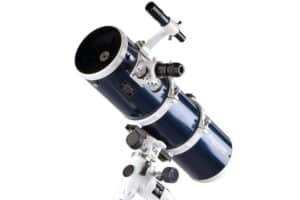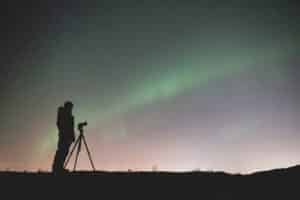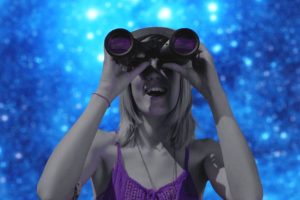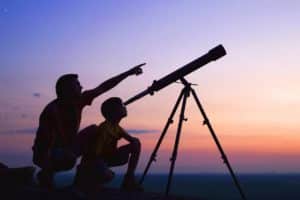When you look at the sky, there is so much more to it than meets the eye. We swim in a dark ocean of stars, planets, galaxies, nebulae, and many fascinating celestial objects. While you can see a lot with the naked eye, you can see even more when you look at the night sky with your first telescope. We hope this article will help you get started with some of our favorite things to see with a telescope.
See also:
What Can You See with a Telescope? Top 6 Things to See First
So, if you recently purchased your first telescope and you’re wondering, “What can I see with a telescope?” – this article is for you. There are loads of things to see with a telescope, but simply buying one and pointing it at the sky can take the wind out of your sails. This guide will give you some tips and 6 ideas to help you get started.
Choosing a Time and Place
As for general tips before we discuss specific things to see: Anytime you want to stargaze with your telescope, the first thing you need to do is decide on a time & place for viewing.
For bright objects (like the planets we’ll mention in this article), your backyard is probably fine but check in advance for cloud conditions. For dimmer objects (like galaxies and nebulae), try to find a cloud-free location with minimal light pollution to set up your telescope. (Or, even better, a dark-sky site.)
You will also want to plan around and avoid meteorological phenomena, which could be anything from dust storms to clouds, which can block your view.
Also, the Sun is NOT one of the objects to look at with a telescope. Unless you have a solar filter over your telescope, you shouldn’t point it at the Sun, because it can damage the lenses in your telescope, and more importantly, your eyes!
How Does a Telescope Work and What Kind of Telescope is Right for You?
Before we get into the exciting things to see with a telescope, we should take a moment to point out that there are several basic types of telescopes, each with different ranges of capabilities, which will ultimately affect what you can see with your telescope.
Based on what they do, you might think telescopes are all highly advanced technological devices that the ordinary person couldn’t even understand. On the contrary, while there are some high-tech telescopes, the basic types are fairly simple to comprehend, and some aspects haven’t changed since Hans Lippershey, a Dutch spectacle maker, invented telescopes in the first place.
As you decide which telescope is right for you, perhaps the most important decision you’ll make is the size of the aperture. Next, you’ll need to decide the type of telescope that best fits your needs. To help with that decision, check out our comparison of reflector vs. refractor telescopes. Finally, we’ve prepared a few guides based on various budget ranges (under $100, $200, $300, $500, and $1000) to help you understand the differences and select the best telescope to buy for you.
(Note that this article focuses on amateur astronomy using beginner-to-intermediate level scopes.)
Finding Things in the Sky
One more thing before we dive in: You’ll need a good way to find things easily in the sky. For most people, the simplest way to get started is to download an app like Stellarium, SkySafari, Star Walk, or SkyView (and there are plenty of others that will also work just fine).
These apps make it super easy to find things. You just open the app, point your phone’s camera towards the sky, and it will tell you exactly what you’re looking at. If you want to get more sophisticated, you can invest in a star chart to help you find things.
Additionally, it’s important to know that what you can see depends on your specific time & location. Here are a few things to consider:
- Seasonality / Time of Year. As the earth rotates around the sun (in each one year cycle), your view of the universe changes. For stars, constellations, galaxies, nebulae, and other distant objects – their location in the sky follows a predictable seasonal pattern as each year goes by.
- Northern or Southern Hemisphere. Did you know that people in the southern hemisphere see a very different view of the universe when they look up, compared to people in the northern hemisphere? In many cases, you can see some of the same targets, but at different times of the year. (For example, the Andromeda galaxy can be seen from both sides of the equator, but at different times of year.) However, some things are only visible from one or the other hemisphere. (For example, Polaris – the north star – is never visible from the southern hemisphere.)
- Planetary Positions. When looking at planets within our own solar system, be aware that each of the planets follows a different orbit around the sun. So, you’ll probably need the assistance of software or an astronomical events calendar to understand (a) whether the planet will be visible in the night sky at different times each year, and (b) where to find each planet against the backdrop of stars in the sky.
So, depending on your location and the season of the year, you should be able to find the following sights. (But keep in mind they won’t all be visible at the same time.)
1. Jupiter
Jupiter is the most massive planet in our solar system. And it’s also one of the easiest planets to locate with your telescope if the conditions are right.
In 2021, you’ll be able to see Jupiter in the mornings starting in late February, appearing progressively earlier and earlier each morning. By August 20, it will reach opposition and then continue appearing progressively earlier in the evenings for the rest of the year.
(Note: Opposition is the time of year when a planet is exactly “opposite” the sun from the earth’s point of view. This provides the perfect time to get the most stunning views. Just like the sun, a planet in opposition will rise from the east right after sunset.)

Because it is the brightest and largest planet in the sky, it’s usually possible to locate Jupiter first with your naked eye, and then aim your finderscope at it. If you see an orangish planet with two belts across its belly, you have found it.
What’s cool about Jupiter is that you can look at Jupiter itself and try to locate the Great Red Spot (though this can be difficult with a beginner’s telescope), or you can steer slightly away from the planet and take a look at the Galilean Moons – i.e. its four biggest moons: Io, Ganymede, Callisto, and Europa. They were first discovered by Galilei Galileo in 1610, and each of them is fascinating eye-candy. (Galileo is also sometimes credited as the inventor of the telescope, but that’s another story.)
If you aim for Jupiter and the Great Red Spot, use a blue color filter for optimal quality. It will improve the definition of the Great Red Spot, as well as the rills and festoons of the cloud belts of Jupiter.
If you aim for Jupiter’s moons, don’t be frustrated if you can’t see all four of them. They are, after all, moons and they are constantly rotating the planet, which means they can be hidden behind the planet as well. Just give it some time and try again.
2. Saturn
Right after Jupiter comes Saturn, the second largest planet in our solar system. It is much further away than Jupiter though, so it is a bit harder to view clearly or in detail without a more powerful telescope. But don’t let that discourage you. It can be done.

As with all the planets, the perfect time to see Saturn in the night sky is during its “opposition”. (Again, this is when the planet is “opposite” the sun.) In 2021, Saturn’s opposition will occur August 2. (Which puts it just a little bit ahead of Jupiter each night as it marches across the sky.)
However, you don’t necessarily need to wait for the opposition to take a look at this gas giant. In 2021, you’ll be able to see Saturn in the mornings starting in early February, appearing each morning progressively earlier until it reaches opposition. Then it will continue appearing earlier and earlier in the evenings for the rest of the year.
(Fun fact: Each year, Saturn’s opposition occurs about two weeks later than the year before. Jupiter’s opposition, on the other hand, happens about one month later each year.)
Also, it is best to use a yellow color filter to observe Saturn. It will make the Cassini Division clearer and crisper. Another color filter you can use is blue, which will cancel out the orange color and make the details in its belts and polar caps more visible.
In clear and ideal weather conditions, you can see Saturn’s rings as well. This includes the A ring and the B ring, and the Cassini Division between them. Additionally, Saturn has a lot of moons too, most famous one being Titan. Among its moons, only 7 of them are observable with a telescope. Titan is the easiest one to spot because of its enormous size.
3. The Moon
Okay, this one is a bit obvious. You see the Moon at night all the time, right?
Well, try taking a look through your telescope and you will definitely notice the difference. It is so much more than just a black and white circle that you stare at when you can’t sleep. It has tons of craters, hills, mountains, and other interesting points to explore.

There are, however, a few things to take into consideration when observing the Moon.
It is best to observe the Moon when it is slightly more than a quarter, like a waxing crescent. This will allow the best light and definition, and you will catch more detail due to the shadows. Also, the terminator, the line dividing the bright and dark areas, will create spectacular silhouettes.
Perhaps unexpectedly, the full moon is the worst stage to observe the Moon. A full moon will be intensely bright, making it more difficult to see details. Also, when observing the Moon with your telescope, you may not want to use full magnification power, as it may blur your view (depending on the power of your telescope). For many telescopes, a lower magnification level works better.
4. Mars
Our smaller red neighbor, Mars, is another great object to look at through your telescope. It is one of the celestial objects you can observe and see quite a lot of surface details and definition.

It can be tricky to observe though, and there are a few things to do to maximize your viewing experience.
First, while the ideal time to see Mars is at its “opposition”, Mars will not reach opposition in 2021. (Its next opposition is in December 2022 – which will provide the spectacular views of the planet.) The good news is that you can still catch Mars in the evening sky until August 22. Then you’ll start to be able to see it again (in late mornings) starting November 24, and it will be visible throughout the entirety of 2022.
Second, you may want to use a red light filter to enhance the overall viewing experience. It will block out the green and blue light, and increase the visibility of surface detail, allowing you a better and more detailed view of the Martian polar caps and the Santa Maria crater.
5. Orion Nebula (M42)
The Orion Nebula, also known as M42 in the Messier Catalog, is a nebula located towards the Orion’s sword region, just under the Orion’s belt, which can be found just at south to southeast at sunrise during late September or early October. (In the northern hemisphere.)
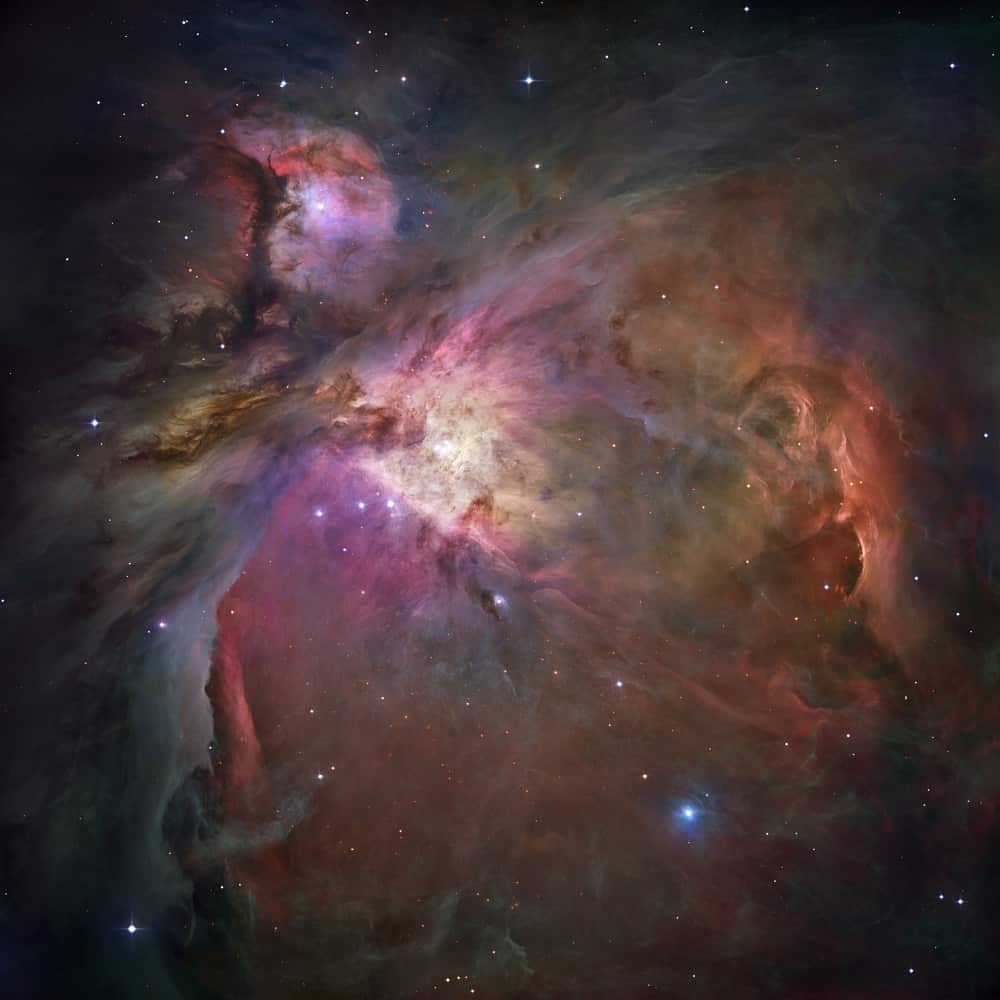
Its specific shape, brightness, and prominence makes it pretty easy to notice and a joy to look at. Its brightness and vivid colors come from the four stars at its core, called the “Trapezium”, which produce amazing colors after ionizing the gasses nearby.
In the right conditions, you can see the Orion nebula with the naked eye, but it is definitely a spectacle to look at with a telescope. For best results, look at it during late fall or in winter and spring. This is because of a lot of reasons including the Sun’s position, the Earth’s latitude and axis, seasonal atmospheric phenomena and distortion and so on.
6. Andromeda Galaxy (M31)
The Andromeda Galaxy, also known as M31 (one of the Messier galaxies), is a part of the Andromeda constellation and it is a galaxy just like our galaxy, the Milky Way. It is filled with trillions of stars, planets, black holes, and many other fascinating celestial objects. It is such an awe-inspiring experience to look at another entire galaxy for the first time.
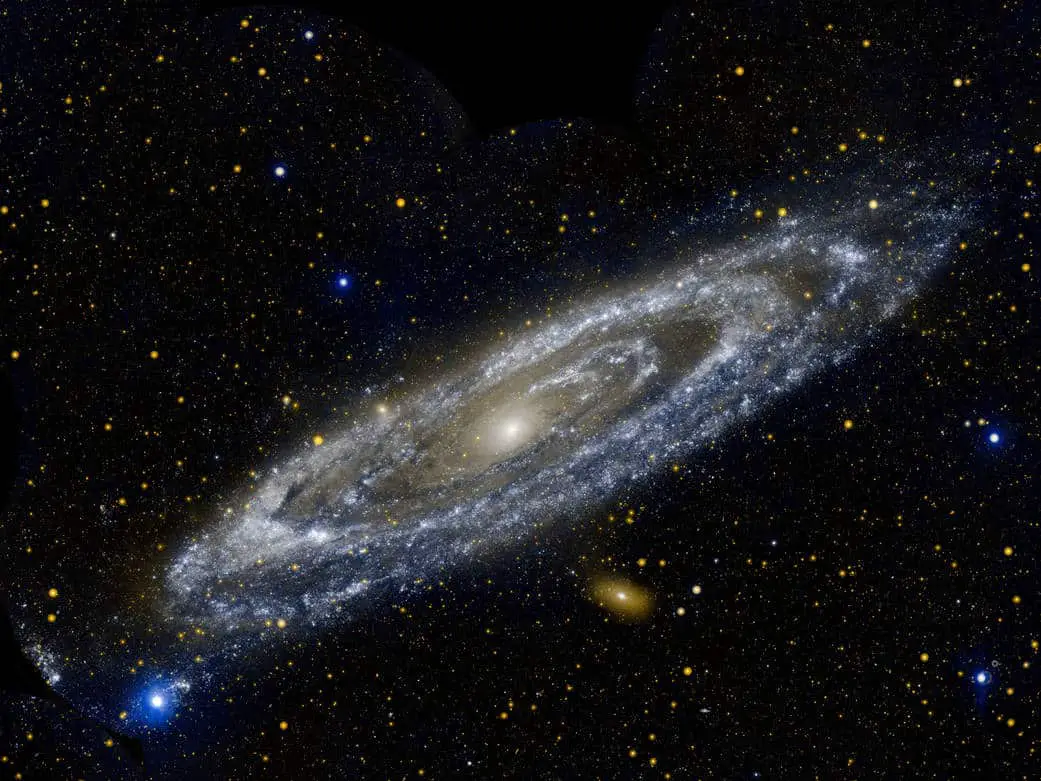
The Andromeda Galaxy is the farthest celestial object that can be seen with the naked eye. (It is 2.5 million light years from Earth!) And it’s also the closest galaxy to ours. Interestingly, the two galaxies are headed towards each other. They will collide and likely merge in about 4 billion years.
The Andromeda Galaxy’s center is very bright. However, due to its distance, it appears quite faint and dim in the eyepiece. So, it can be tricky and frustrating for a beginner to find it. Also, since it is such a colossal galaxy, it probably won’t fit into the view of your telescope in its entirety.
For best results in the northern hemisphere, look at it in the fall and winter, because these are the times that the Andromeda Galaxy and the Earth are best aligned for good viewing. The best way of finding it is by using an app on your smartphone (or looking at a star chart). A good rule of thumb is that it is located just ahead of the ‘W’ formation of the Cassiopeia constellation.
Be aware that Andromeda is visible at different times from both the southern and the northern hemisphere. For the northern hemisphere, the best viewing is from August to February. In the southern hemisphere, October to December.
Final Thoughts
While the ideas in this article are some of our favorite things to see in the night sky – it’s just a place to start. There is literally an infinity of beauty to be found in the universe. And with a good telescope, we hope you’ll be able to explore much more of it. Be sure to check out the rest of this website for more ideas and advice as you’re getting started in your astronomy journey.
(Also, if you liked this article, please share it using the social media buttons below!)
Feature Image Credit: NASA; ESA; A. Simon (Goddard Space Flight Center) and M. H. Wong (University of California, Berkeley)

